Related Research Articles

The Cambrian is the first geological period of the Paleozoic Era, and the Phanerozoic Eon. The Cambrian lasted 53.4 million years from the end of the preceding Ediacaran period 538.8 Ma to the beginning of the Ordovician Period 485.4 Ma.

The Ediacaran is a geological period of the Neoproterozoic Era that spans 96 million years from the end of the Cryogenian Period at 635 Mya to the beginning of the Cambrian Period at 538.8 Mya. It is the last period of the Proterozoic Eon as well as the last of the so-called "Precambrian supereon", before the beginning of the subsequent Cambrian Period marks the start of the Phanerozoic Eon, where recognizable fossil evidence of life becomes common.
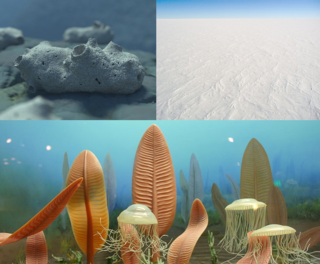
The Neoproterozoic Era is the last of the three geologic eras of the Proterozoic eon, spanning from 1 billion to 538.8 million years ago, and is the last era of the Precambrian "supereon". It is preceded by the Mesoproterozoic era and succeeded by the Paleozoic era of the Phanerozoic eon, and is further subdivided into three periods, the Tonian, Cryogenian and Ediacaran.
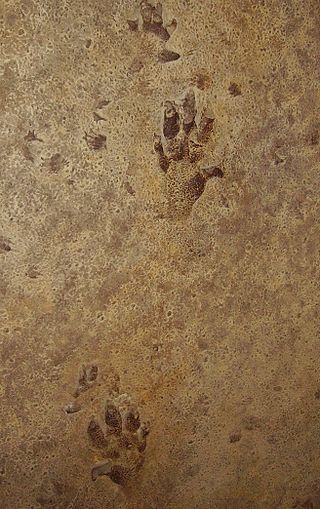
A trace fossil, also known as an ichnofossil, is a fossil record of biological activity by lifeforms but not the preserved remains of the organism itself. Trace fossils contrast with body fossils, which are the fossilized remains of parts of organisms' bodies, usually altered by later chemical activity or by mineralization. The study of such trace fossils is ichnology - the work of ichnologists.

Kimberella is an extinct genus of bilaterian known only from rocks of the Ediacaran period. The slug-like organism fed by scratching the microbial surface on which it dwelt in a manner similar to the gastropods, although its affinity with this group is contentious.
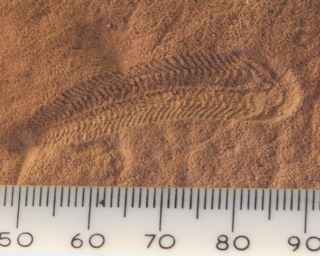
Spriggina is a genus of early animals whose relationship to living animals is unclear. Fossils of Spriggina are known from the late Ediacaran period in what is now South Australia. Spriggina floundersi is the official fossil emblem of South Australia; it has been found nowhere else.

Vendobionts or Vendozoans (Vendobionta) are a proposed very high-level, extinct clade of benthic organisms that made up of the majority of the organisms that were part of the Ediacaran biota. It is a hypothetical group and at the same time, it would be the oldest of the animals that populated the Earth about 580 million years ago, in the Ediacaran period. They became extinct shortly after the so-called Cambrian explosion, with the introduction of fauna forming groups more recognizably related to modern animals. It is very likely that the whole Ediacaran biota is not a monophyletic clade and not every genus placed in its subtaxa is an animal.
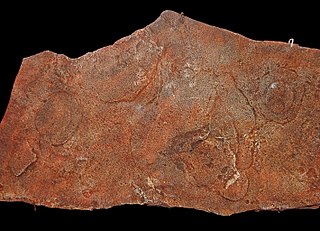
Ediacaria is a fossil genus dating to the Ediacaran Period of the Neoproterozoic Era. Unlike most Ediacaran biota, which disappeared almost entirely from the fossil record at the end of the Period, Ediacaria fossils have been found dating from the Baikalian age of the Upper Riphean to 501 million years ago, well into the Cambrian Period. Ediacaria consists of concentric rough circles, radial lines between the circles and a central dome, with a diameter from 1 to 70 cm.

The Ediacaranbiota is a taxonomic period classification that consists of all life forms that were present on Earth during the Ediacaran Period. These were enigmatic tubular and frond-shaped, mostly sessile, organisms. Trace fossils of these organisms have been found worldwide, and represent the earliest known complex multicellular organisms. The term "Ediacara biota" has received criticism from some scientists due to its alleged inconsistency, arbitrary exclusion of certain fossils, and inability to be precisely defined.

The "Cambrian substrate revolution" or "Agronomic revolution", evidenced in trace fossils, is a sudden diversification of animal burrowing during the early Cambrian period.
The end-Ediacaran extinction is a mass extinction believed to have occurred near the end of the Ediacaran period, the final period of the Proterozoic eon. Evidence suggesting that such a mass extinction occurred includes a massive reduction in diversity of acritarchs, the sudden disappearance of the Ediacara biota and calcifying organisms, and the time gap before Cambrian organisms "replaced" them. Some lines of evidence suggests that there may have been two distinct pulses of the extinction event, one occurring 550 million years ago and the other 539 million years ago.
The small shelly fauna, small shelly fossils (SSF), or early skeletal fossils (ESF) are mineralized fossils, many only a few millimetres long, with a nearly continuous record from the latest stages of the Ediacaran to the end of the Early Cambrian Period. They are very diverse, and there is no formal definition of "small shelly fauna" or "small shelly fossils". Almost all are from earlier rocks than more familiar fossils such as trilobites. Since most SSFs were preserved by being covered quickly with phosphate and this method of preservation is mainly limited to the late Ediacaran and early Cambrian periods, the animals that made them may actually have arisen earlier and persisted after this time span.
The Cambrian explosion is an interval of time beginning approximately 538.8 million years ago in the Cambrian period of the early Paleozoic, when a sudden radiation of complex life occurred and practically all major animal phyla started appearing in the fossil record. It lasted for about 13 to 25 million years and resulted in the divergence of most modern metazoan phyla. The event was accompanied by major diversification in other groups of organisms as well.

Reticulosa is an extinct order of sea sponges in the class Hexactinellida and the subclass Amphidiscophora. Reticulosans were diverse in shape and size, similar to their modern relatives, the amphidiscosidans. Some were smooth and attached to a surface at a flat point, others were polyhedral or ornamented with nodes, many were covered in bristles, and a few were even suspended above the seabed by a rope-like anchor of braided glass spicules.
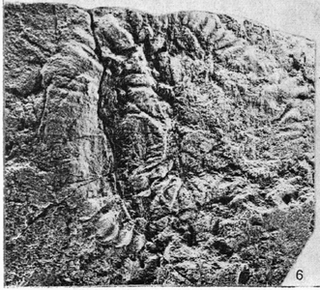
Veprina is a rare Ediacaran coelenterate cnidarian found on the Zimny coast of the White Sea, Russia and was first described by Mikhail Fedonkin in 1980.
Studenicia is a genus of Ediacaran fauna which is approximately 635-545 million years old. All Ediacaran fauna are considered to be invertebrate Metazoans or multicellular organisms with no backbone.
Palaeoplatoda is a genus from the Ediacaran biota. It is a soft-bodied organism with a segmented body that resembles Dickinsonia, another Ediacaran organism.
Podolimirus is an extinct monotypic genus of unclassified proarticulates. It presents a single species, Podolimirus mirus. It was found in strata of the late Ediacaran, at the beginning of the Cambrian. It is one of the last proarticulates. The first fossils of this genus and species were found in the Ukraine along the Dneister River close by to the deposits in the Vendian Sequence in 1983.

Tateana, and more specifically Tateana inflata, is a very small, discus-like Ediacaran fossil. Its largest diameter is 6.4 mm long and it is radially symmetrical. It has very defined and thin radial striations. The main body seemed to be the main portion of the fossil, not showing signs of any limbs or appendages. Tateana has a central zone to where all the radial striations meet into the middle. The striations do not branch off of a main path and there are about 100 of them on the body.
References
- 1 2 3 Vickers-Rich, Patricia; Komarower, Patricia (2007). The Rise and Fall of the Ediacaran Biota. ISBN 9781862392335.
- ↑ Upper Precambrian and Cambrian Palaeontology of the East-European Platform. Wydawnictwa Geologiczne. 1983. ISBN 9788322001387.
- ↑ Mienasova, A. (2019). "Reconstruction of Survival Curves in the Study of Soft-Body Organisms' Nature and Living Conditions from Upper Vendian Deposits in the Middle Dniester Area". Monitoring 2019. pp. 1–5. doi:10.3997/2214-4609.201903255. S2CID 239111220.
- ↑ "Affinities and Taphonomy of a Cambrian Discoid from Guizhou, South China". cambridge.org. Retrieved 14 April 2022.